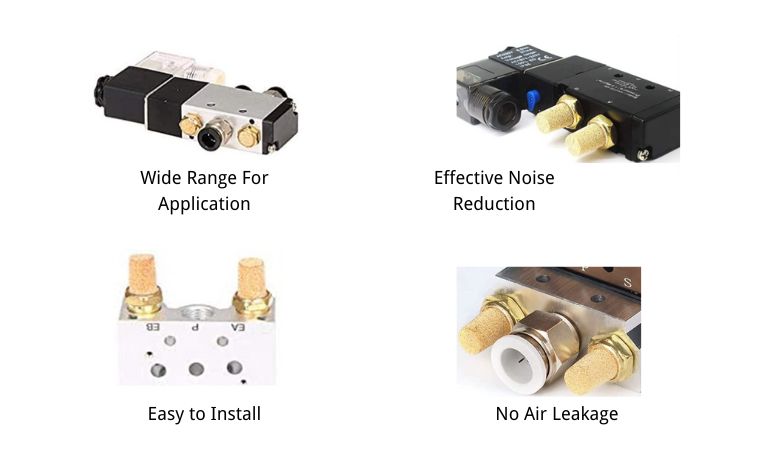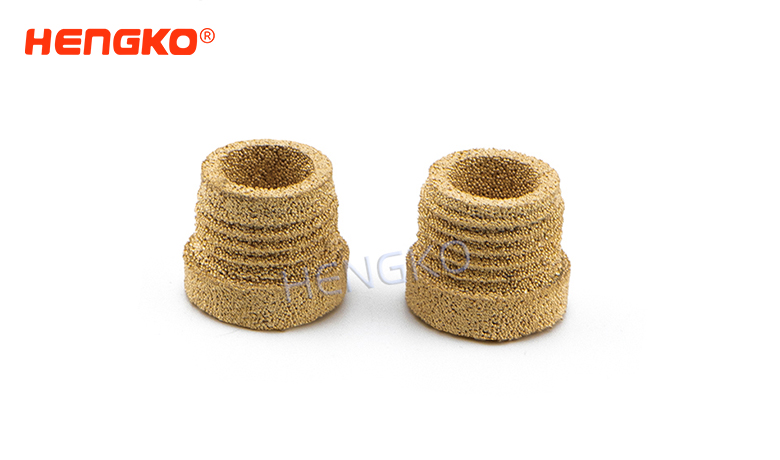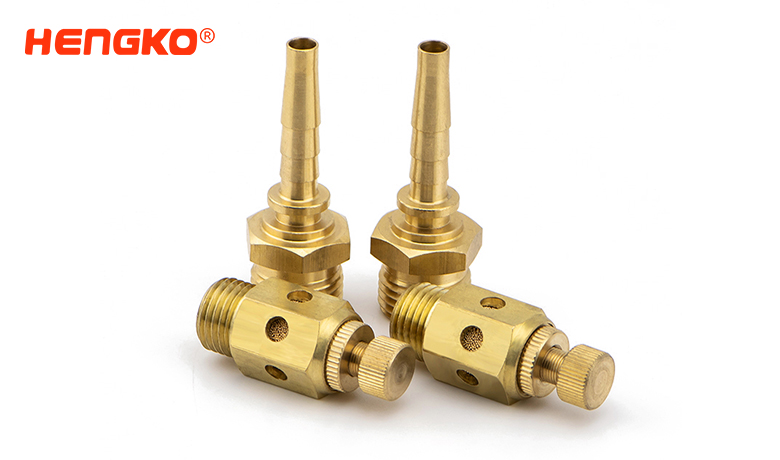
What Is a Pneumatic Muffler?
Do you know what is a so-called pneumatic muffler? Actually, the pneumatic muffler is applied to many devices in various industries. Here is an answer for you.
Pneumatic air mufflers, also commonly referred to as pneumatic mufflers, are a cost-effective and simple solution that reduces noise levels and unnecessary pollutant emissions from pneumatic devices. The silencer may also include adjustable throttle valves to control the air flow rate as it leaves the silencer.
What Is the Working Principle of a Pneumatic Muffler?
Maybe you know the importance of a pneumatic muffler, but do you know the working principle of a pneumatic muffler? Here we list it for you.
The working principle of pneumatic silencers is to vent pressurized air after operating at safe noise levels and prevent the discharge of contaminants (if used in combination with a filter). Excessive noise may be produced when compressed air is released into the environment. Noise results from turbulent air due to the collision of fast-moving air released from the vents with static air in the environment. Typically, the silencer is installed directly at the vent of the valve and diffuses the released air through a larger surface area, reducing turbulence and noise levels. Pneumatic exhaust mufflers are typically designed with porous materials to increase the surface area of the exhaust ports they cover. They can also be mounted on a hose.
What Is the Function of a Pneumatic Muffler?
In this part, we state the functions of pneumatic mufflers for you.
①It plays the role of silencing, used to reduce exhaust pulsation and reduce exhaust noise as much as possible. The sound is very large when the solenoid valve exhausts, especially when the number of the solenoid valve is more. The installation of a silencer can effectively reduce noise;
② It can prevent dust and other small particles in the environment into the solenoid valve. Otherwise, the particles in the solenoid valve will lead to a block of the movement of the solenoid valve spool, thus reducing the service life of the solenoid valve.
Non-standard equipment is usually used in a quiet environment, the sound will affect the work of equipment operators if they have been listening to the irritating sound, so the muffler is also an indispensable part of the air path system.
What are the Advantages and Disadvantages of Bronze and Stainless Steel?
As we all know, different materials have different characteristics as well as advantages and disadvantages. In this part, we mainly illustrate the advantages and disadvantages of bronze and stainless steel for you.
Bronze
1. Advantage:
① Physical properties: with high strength, it's not easy to be damaged by the outside in terms of structure. The structure is solid, so it can always perform normally.
② Chemical properties: it has stable chemical properties and good acid and alkali resistance
③ Process performance: with good flexibility and process performance, it is easier to be processed and can be molded in a hot or cold state. The strength is moderate (200~360MPa), and its deformation resistance is greater than aluminum's but much smaller than steel and titanium. Its plasticity is very good, and it can withstand large deformation of cold and hot pressure processing, such as rolling, extrusion, forging, stretching, stamping, and bending. The deformation degree of bending, rolling, and stretching can reach 95% without intermediate annealing and other heat treatment.
2. Disadvantage
In a humid environment, bronze is extremely easy to oxidize, generating patina, making the copper surface tarnish, and difficult to clean.
Stainless Steel:
Advantage:
①Physical properties: heat resistance, high-temperature resistance, low-temperature resistance and even ultra-low temperature resistance;
②Chemical properties: chemical corrosion resistance and electrochemical corrosion performance in steel is very good, second only to titanium alloy;
③Process performance: austenitic stainless steel process performance is the best due to good plasticity. It can be processed as a variety of plates, tubes and other shapes suitable for pressure processing. The process performance of martensitic stainless steel is poor due to high hardness;
④Mechanical properties: according to the different kinds of stainless steel, the mechanical properties of each are not identical, martensite stainless steel with high strength and hardness is suitable for manufacturing parts with corrosion resistance, high strength, and high abrasion resistance, such as turbine shaft, stainless steel cutlery, stainless steel bearings. The plasticity of austenitic stainless steel is very good without too much intensity. Still, the corrosion resistance is one of the best in stainless steel, suitable for the occasion where corrosion resistance is required, and mechanical property requirements are not high.
2. Disadvantage
① Higher Cost: the main disadvantage of stainless steel is its high cost, the price is higher, and the average consumer is difficult to consume.
② Weaker alkali resistance: stainless steel is not resistant to corrosion of alkaline media. Unsuitable long-term use or maintenance will cause more serious damage to stainless steel.
How to Choose a Good Pneumatic Muffler for Your Devices?
When you choose a pneumatic muffler, the first thing you should do is to determine where you will apply it to. The recommendation of a pneumatic muffler varies from the application. In this part, we will introduce the application and some air mufflers for you.
1. Application:
Air silencers can be applied to many aspects. Applications that operate pneumatic devices at high frequencies and generate a lot of noise are ideal for pneumatic silencers. Here we list some examples below:
①Robotics: pneumatic techniques are often used in the area of the robot to control the movement or perform on a load. Because robots usually have a robotic arm, which needs pneumatic devices to control the movement. Therefore, it is of great importance to control the noise caused by the exhaust.
②Packaging: Pneumatic devices are commonly used in packaging machines to drive movement. Sorters typically transfer products based on signals from industrial controllers. The signal from the controller is used to start the pneumatic device. Due to the high rate of packaging machines and the large number of workers that usually surround these machines, pneumatic silencers will be suitable for packaging machines.
③Fence production machinery: machines that manufacture fence rolls often include cylinders to cut the fence, as the fence is braided into rolls. An operator works continuously with the fence production machinery to ensure that the fence rolls meet specifications. Pneumatic silencers are recommended to reduce the noise of continuously running machinery, so as to protect the operator from destructive noise.
2.Recommended Pneumatic Silencer
Pneumatic Sintered Mufflers Filters utilize porous sintered bronze filter elements secured to standard pipe fittings. These compact and inexpensive mufflers are easy to install and maintain, particularly suitable for limited space. They are used to diffuse air and muffler noise from the exhaust ports of air valves, air cylinders, and air tools to an acceptable level within OSHA noise requirements.
Mufflers are porous sintered bronze parts used to reduce the output pressure of compressed gas, thus reducing noise when the gas is evacuated. They are made with B85 grade bronze, with a filtering efficiency of 3-90um.
- Works with pressures up to 10 bar for industrial use
- G1/8 thread is highly compatible with standard pneumatic systems
- Wide operating temperature of -10°C to +80°C for use in harsh industrial environments
- It can be used with lubricants for reduced wear and tear
Application Environment:
• Industrial automation
• Robotics
• Mechanical engineering
• Packaging and material handling
②Sintered Bronze Muffler 40 Micron Pressure Relief Valve Waterproof Breather Vent Fitting
Pneumatic Sintered Mufflers Filters utilize porous sintered bronze filter elements secured to standard pipe fittings. These compact and inexpensive mufflers are easy to install and maintain, and particularly suitable for limited space. They are used to diffuse air and muffler noise from the exhaust ports of air valves, air cylinders, and air tools to an acceptable level within OSHA noise requirements.
Mufflers are porous sintered bronze parts used to reduce the output pressure of compressed gas, thus reducing noise when the gas is evacuated. They are made with B85 grade bronze, which has a filtering efficiency of 3-90um.
Application Environment:
Blowers, compressors, engines, vacuum pumps, air motors, pneumatic equipment, fans, and any other application that requires reduced noise level.
In conclusion, pneumatic air mufflers, referred to as pneumatic mufflers, are a cost-effective and simple solution that reduces noise levels and unnecessary pollutant emissions from pneumatic devices. It can be made of stainless steel or bronze. When you choose a pneumatic muffler, you should consider its application.
If you also have projects that need to use a Air Muffler Silencer, you are welcome to contact us for details, or you can send an email to ka@hengko.com. We will send back within 24 hours.
Post time: Nov-11-2022







